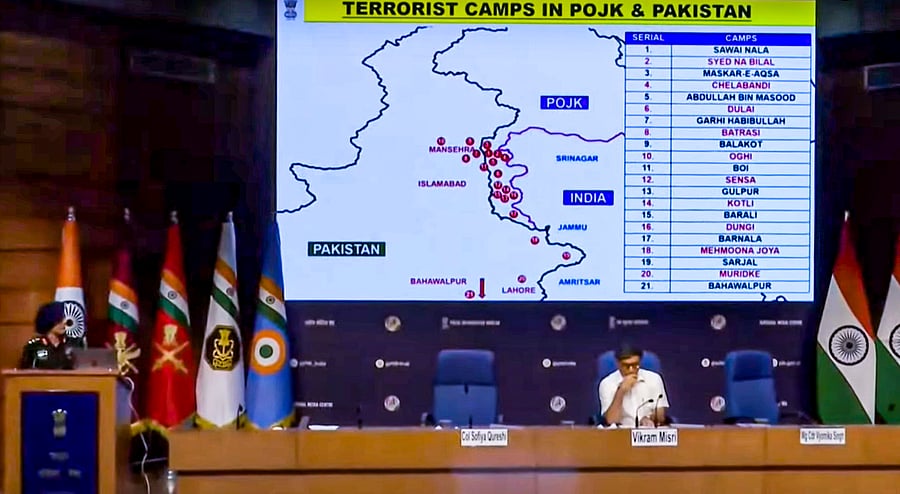
Army's Col Sofiya Qureshi speaks as Foreign Secretary Vikram Misri looks on during a press conference regarding 'Operation Sindoor', in New Delhi.
Credit: PTI Photo
New Delhi: Two weeks into the Pahalgam carnage, Indian armed forces on Wednesday launched Operation Sindoor, a retaliatory strike hitting at the core of the terror infrastructure inside Pakistan and Pakistan-Occupied Jammu and Kashmir destroying nine terror camps including the Jaish-e-Mohmmed headquarters at Bahawalpur and Lashkar-e-taiba alma-mater at Muridke killing 70-100 terrorists.
In a span of 25 minutes between 0105 and 0130 hours, the Indian Army and Indian Air Force platforms fired two dozen missiles and other smart weapons to hit eight terror camps within 30 km of the Line of Control and International Border besides the high-value JeM establishment at Bahawalpur, almost 100 km from the IB in Pakistan’s Punjab province.
The armed forces chose four targets in Pakistan and five in PoJK based on "credible intelligence" about terror camps operating at these sites, camouflaged as health centres to evade detection and circumvent sanctions from international organisations, including the Financial Action Task Force, officials said.
Soon after the successful and well-coordinated operation, National Security Advisor Ajit Doval spoke to his counterparts in several countries conveying that India has no intent to escalate tensions but is prepared to "retaliate resolutely" if Pakistan does so, officials said.
Sources said targets near the LoC and IB were hit by the Indian Army while the far ones including the terror camp at Bahawalpur was struck by the IAF with its long-range weapons. “Smart weapons and precision ammunition were used,” an official said.
“The strike on the terror camps was undertaken through precision capability, using niche technology weapons with careful selection of warheads that ensured no collateral damage. The point of impact in each of the target was a specific building or a group of buildings,” IAF officer Wing Commander Vyomika Singh said at a media briefing here.
Wing Command Singh along with Col Sofiya Quereshi from the Indian Army briefed the media hours after the Defence Ministry issued a brief statement on the operation.
“Operation Sindoor was launched by Indian armed forces to deliver justice to the victims of Pahalgam terror attack and their families. Nine terrorist camps were targeted and successfully destroyed,” said Col Quereshi.
The Cabinet Committee on Security chaired by Prime Minister Narendra Modi reviewed the situation following the retaliatory strike by the armed forces.
Indian officials asserted that no military establishments were targeted and there were no reports of any civilian collateral damage.
“India has demonstrated considerable restraint in its response. However, Indian armed forces are fully prepared to respond to Pakistani misadventure, if any, to escalate the situation,” Wg Cdr Singh said.
Sources said Indian air defence systems close to the western border were on high alert in anticipation of any action from Pakistan, which opened up artillery shelling across the border in Jammu and Kashmir following the Indian strike, killing at least 15 civilians.
India’s air-borne radar systems and frontline fighter jets are also flying close to Pakistan border because of an ongoing air exercise in the desert sector.
The first terror unit destroyed by the Indian Army was the Abbas Camp at Kotli followed by the Gulpur camp frequented by Zaki-ur-Rehman Lakhvi, the 26/11 mastermind, for indoctrination campaigns. The Sawai Nala camp in Muzaffarabad used by the terrorists for Pahalgam attack was also decimated.
Of the nine terror camps, four were used by the LeT, two by JeM and one by Hijbul Mujahideen. Other two were used for training the terrorists and launching them for India.
While the surgical strike after the Uri terror attack and the Balakot air strike following the Pulwama massacre were limited to areas with POKJ, this time the armed forces hit deep within Pakistan such as Bahawalpur and Muridke.
“Our actions were measured, non-escalatory, proportionate and responsible. They focussed on dismantling the terrorist infrastructure and disabling terrorists likely to be sent across to India. Our intelligence monitoring of Pakistan-based terrorist modules indicated that further attacks against India were impending,” Foreign Secretary Vikram Misri said.
